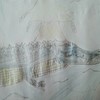HOME | DD
 Eldr-Fire — The Weaver of Xuenkal
Eldr-Fire — The Weaver of Xuenkal

#archaeology #historical #history #loom #maya #medieval #weaver #weaving #yucatan #mayan #medievalarchitecture #medievaldress #medievaltimes #medievaltown #mexican #mexicana #mexicanart #mexicanculture #tropical #tropicalforest #historicalfashion #medievallady #mexicanwomen #historicalclothing #historicallyaccurate
Published: 2018-06-18 07:50:49 +0000 UTC; Views: 3201; Favourites: 58; Downloads: 2
Redirect to original
Description
As the civilisation known later as the "Classic Maya" began to collapse and reform, a city called Chichén Itzá seized power. For the past hundred years, its leaders had been undertaking an aggressive expansion of their empire in the Yucatán peninsula. Smaller neighbouring cities had to adapt to the new balance of power in the region if they wanted to survive. One of these cities was Xuenkal, located halfway between Chichén Itzá and its port city of Isla Cerritos on the Gulf of Mexico. While many others nearby rapidly depopulated, Xuenkal thrived with new construction imitating the ideological architecture of Chichén Itzá. Their survival and adaptation was only possible because the women of Xuenkal rapidly adjusted their textile production to keep up with the tribute demands of their powerful imperial rulers.The weaver you see here works on one of the new free-standing platforms built in the Terminal Classic period during the height of Chichén Itzá's dominance of Xuenkal. Spindle whorls found on the site tell us that this platform, known as FN-129 to archaeologists, was a hub of highly specialised textile production. Her patio faces the walled inner city of Xuenkal to the north and housed many other crafting specialists, but the elite textile production was of utmost importance to the new political reality. In this scene the expert weaver is using a backstrap loom with an agave fiber cloth supporting her, the loom tied to another pillar on the patio to suspend it while she weaves. At other stages during the weaving process she used spindle whorls decorated with insignia that relate them to various Mayan goddesses, such as the shield of the goddess Toci who protects women during the battle of childbirth, or floral and bird designs associated with the goddess Xochiquetzal who oversaw weaving as well as female sexuality. Before Chichén Itzá's ascent to power, women in Xuenkal would have produced little more than what their families needed, but at platforms like FN-129 they now mass-produced elite textiles to serve as tribute.
I drew the weaver wearing a white huipil made of either cotton or agave, as depicted in a mural from Chichén Itzá. The fact that she wears white feathers in the mural suggests she was high enough in status to wear feathers, usually reserved to the elite, but not important enough to wear colourful imported feathers - instead, she sports two feathers from a domestic duck. Although the mural doesn't depict any face paint, I gave her face paint inspired by Kamazotz 's Postclassic Yucatán outfit reconstructions . My interpretation of her headdress was also informed by his Mayan hairstyles reference sheet .
The way these women adjusted the subsistence weaving techniques they had learned from their mothers and grandmothers to keep up with the demands of their new political situation is truly remarkable. The scholars who analysed the spindle whorls on FN-129 put it best: "Far from being isolated from or immune to pan-Mesoamerican political changes, Classic Maya women and their typically domestic activities such as cloth and craft production were integral components of the economic and ideological transformations during the Terminal Classic period. Indeed, as growing research on the manipulation of gender roles shows, reinforcement of the coupling of gender with production was an effective means by which expansive states met the needs of an elite increasingly engaged in nonproductive activities such as war and political ritual. From this perspective, women weavers may have shouldered some of the most pronounced demands of the Terminal Classic Itzá polity."
Here is the next entry in my Women of 1000 AD series! At first Mexico was a bit of a headscratcher because 1000 AD occupies a gap between the well-documented Classic Maya and the European encounter in the Late Postclassic period. It would have been much easier to research a woman from a few centuries earlier! But I'm grateful to kamazotz for sending me the Chichén Itzá mural which helped me figure out what a woman from the Terminal Classic/Early Postclassic period might look like. I'm also indebted to Dr Traci Ardren of the University of Miami who was one of the authors contributing to the article quoted above and has written a great deal about historical Mesoamerican women and children. (By a funny coincidence, she's also one of my mom's friends from grad school!) She answered my questions when I emailed her and was very supportive of my project! 
Thanks to SachiiA for her help and encouragement, which really got me through this picture. I was going to do a different one next, but playing an archaeologist in The Sims 4: Jungle Adventure made me really want to draw Mexico next! It was fun working on this picture while cheering on the Mexican football team in yesterday's World Cup!
Others in the Series
Sei Shōnagon
Oni Oluwo
Princess Olith
Coniupuyara
Sitt al-Mulk and Taqarrub
The Mother of Pueblo Bonito
Gudridr Thorbjarnardottir and Thorbjorgr Litlvolva
Niguma
Guni
Bonna
The Oneota Messenger
Empress Chengtian
The Pilgrim of Pariti
Queen Gurandukht
Mwana Mkisi
Raingarde
Ama
Sahiqat
Jigonsaseh
Project Website
Related content
Comments: 16

👍: 0 ⏩: 1

👍: 0 ⏩: 1

👍: 1 ⏩: 0

truly interesting!!! another time and place I didn't know much about… thanks for the discovery!
👍: 0 ⏩: 1

Thank you so much, glad you enjoyed!
👍: 0 ⏩: 1

Wow, I was absent from DA for quite some time and I forgot about your 'women of 1000 AD' series - this is such a cool concept! Well done! It is good to see such creative ideas and works 

👍: 0 ⏩: 1

Thank you so much for all your wonderful comments! It is always good to hear from you again. 
👍: 0 ⏩: 0

This is beautiful! I love how much effort and research you put into all of these!
👍: 0 ⏩: 1

























